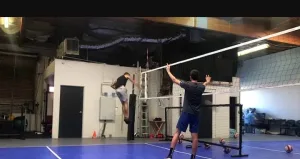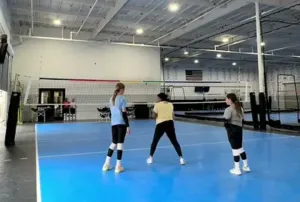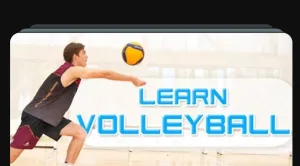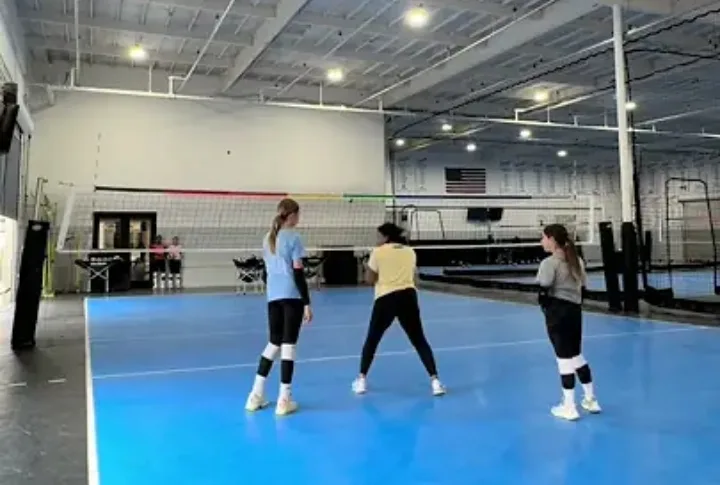How to Teach Volleyball to Beginners: A Step-by-Step Guide: Teaching volleyball to beginners can be a rewarding experience. Whether you’re coaching a youth team, teaching volleyball to kids, or introducing friends to the game, guiding them through the basics is essential. In this article, we’ll show you how to teach volleyball to beginners in a step-by-step guide, which will help them develop fundamental skills while having fun.
How to teach Volleyball to beginners: Step 1. Setting Up the Court and Explaining the Rules

When teaching volleyball to beginners, don’t jump into drills and exercises; it’s very important to start by explaining the game and its rules. Beginners need a clear understanding of how the game is played, where the lines are, and what the objectives are.
How to:
- Court Setup: Show them where the boundaries are—the sidelines, end lines, and the centerline. Explain how the net divides the court and the importance of each player’s position on the court.
- Basic Rules: Teach them that volleyball is about keeping the ball in play and sending it over the net within three hits. Players rotate positions after winning a point from the opposing team’s serve. Keep it simple, and don’t overwhelm them with advanced rules at first.
How to teach Volleyball to beginners: Step 2. Teach essential volleyball skills for beginners.

Once they understand the game, it’s time to dive into the core skills. Here’s how to teach each essential skill:
-
Passing (Forearm Pass/Underhand Pass)
Passing is one of the most fundamental volleyball skills. It’s the first touch on the ball after it comes over the net.
See Also: 7 Types of Passes in Volleyball
How to teach:
- Have beginners stand with their feet shoulder-width apart and knees slightly bent.
- Teach them to clasp their hands together, keeping their arms straight to form a flat surface for the ball to hit.
- Encourage them to move towards the ball rather than waiting for it to come to them.
Example Drill: Toss a ball underhand to each player and have them pass it back to you using the correct form. Gradually increase the speed and distance to help them improve their reaction time.
Read more: Underhand Serve in Volleyball: Meaning and Step-by-Step Guide
-
Setting
Setting is a crucial skill that allows teammates to hit the ball effectively.
How to teach:
- Start by showing them how to position their hands above their heads in the shape of a triangle or diamond.
- As the ball approaches, they should slightly bend their knees and push the ball upwards with their fingertips, not their palms.
Example Drill: Stand a few feet away from each player and gently toss the ball above their heads. Have them set it back to you, emphasizing quick reactions and soft touches.
-
Serving
Serving is how every rally begins, and it’s one of the easiest skills to practice at any level.
How to teach:
- For beginners, focus on the underhand serve. Have them hold the ball in one hand and swing the other arm to hit the ball from underneath.
- Encourage them to keep their eyes on the ball and aim for the middle of the court.
Example drill: Line players up behind the serving line and let them take turns serving. Reward accurate serves and help them adjust their technique as needed.
-
Hitting (Spiking)
Spiking can be intimidating for beginners, but breaking it down into smaller steps makes it more manageable.
How to teach:
- Start by teaching the approach: a three-step movement where the player moves towards the ball, jumps, and swings their arm to hit it.
- Emphasize timing and accuracy over power at first.
Example Drill: Set up a small net or even a rope across the court. Let players practice their approach and hitting form without worrying about height or power.
Read more: Volleyball Hitting Drills: Improve Your Spike, Power, and Accuracy
-
Blocking
Blocking helps defend against powerful spikes from the opposing team.
How to teach:
- Show beginners how to position themselves near the net with their arms raised.
- Have them jump with both arms straight up, timing their movement with the hitter’s approach.
Example Drill: Practice blocking by having one player lightly spike the ball while another attempts to block it.
Step 3. Volleyball Drills: Fun and Engaging Drills for Beginners
Volleyball is more enjoyable when beginners feel they’re improving, so creating fun and engaging drills is key. Here are a few ideas:
- Bump-Set Drill: Have players pass the ball (bump) and then set it. This helps them get comfortable with two key skills.
- Target Practice: Use cones or buckets as targets on the other side of the net. Let players practice serving or hitting toward the targets.
- Mini Games: Divide the group into small teams and have short games to let them apply their skills in a less formal setting.
Building Confidence and Teamwork
Volleyball is a team sport, so building confidence and teamwork is essential. Encourage players to communicate on the court, calling for the ball or directing teammates. Positive reinforcement goes a long way in building confidence. Celebrate small victories and improvements, even if they’re just getting better at passing or serving.
Common Mistakes and How to Correct Them
It’s common for beginners to make mistakes as they learn new skills. Here’s how to fix a few common issues:
- Passing with Bent Arms: Beginners often bend their elbows when passing. Correct this by reminding them to keep their arms straight and form a solid platform.
- Not Following Through on Serves: Beginners may stop their motion after hitting the ball. Encourage them to follow through with their swing for more accurate serves.
- Hitting with Palms: When setting, some beginners will use their palms instead of their fingertips. Have them practice soft, controlled touches using just their fingertips.
See Also: Volleyball Violations and Mistakes
Conclusion: How to Teach Volleyball to Beginners

Teaching volleyball to beginners doesn’t have to be complicated. By breaking down the skills, practicing with fun drills, and focusing on communication and teamwork, you’ll help new players develop a love for the game. Remember, patience is key. The more comfortable and confident beginners feel, the faster they’ll improve.
FAQs
1. How long does it take to teach volleyball to beginners?
It depends on the individual or group, but most beginners start getting the hang of the basics after a few practice sessions. Consistency in practice and positive reinforcement can speed up the learning process.
2. What’s the easiest volleyball skill to teach beginners?
Passing is usually the easiest skill to start with. It’s foundational to the game, and once players master the basics of passing, they can build on that knowledge to learn other skills like setting and hitting.
3. How can I keep volleyball fun for beginners?
Incorporate a lot of games and fun drills. Start with easy activities that don’t overwhelm them, and gradually increase the difficulty as they improve. Keeping the atmosphere positive and rewarding small improvements also helps keep things fun.
4. What are common mistakes beginners make in volleyball?
Beginners often bend their arms while passing, miss the ball entirely when serving, or fail to communicate with teammates. With regular feedback and correction, these mistakes become less frequent over time.
5. How can I help beginners improve their serving?
Start with the underhand serve, as it’s easier for beginners. Encourage them to practice regularly, focusing on accuracy before power. Providing a target for serves can also help improve precision.
By following this guide, you’ll be well-equipped to teach volleyball to beginners and help them grow in confidence and skill. With patience, encouragement, and consistent practice, they’ll be spiking and setting like pros in no time!
